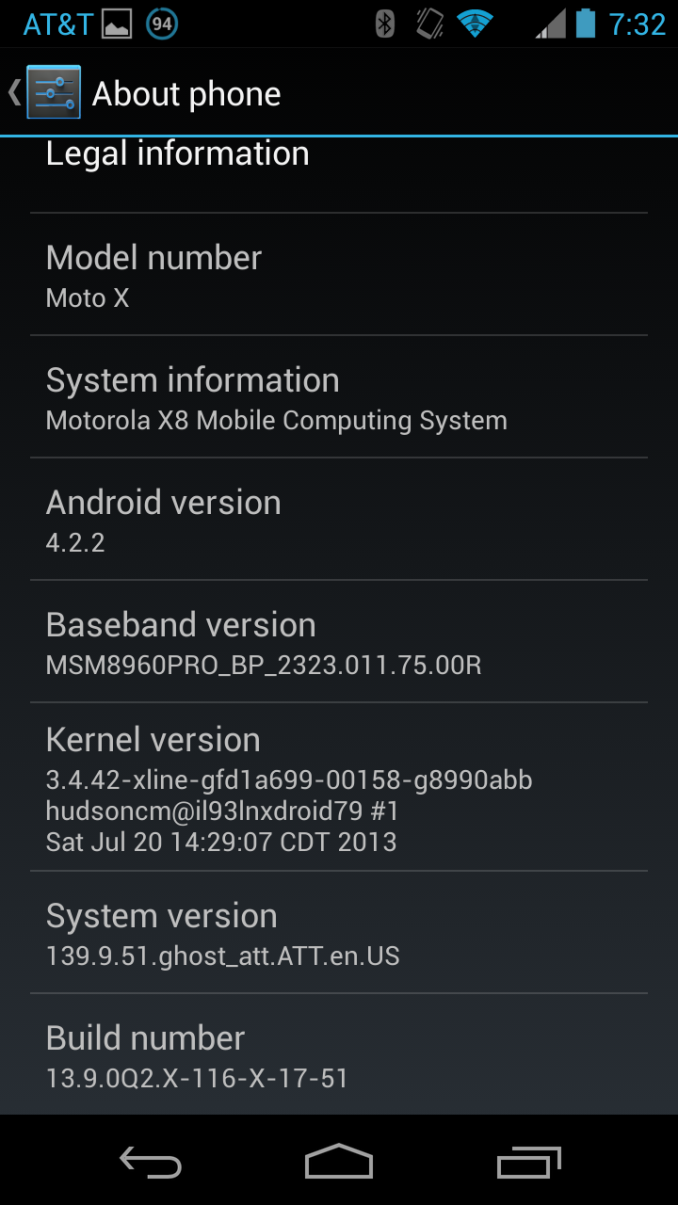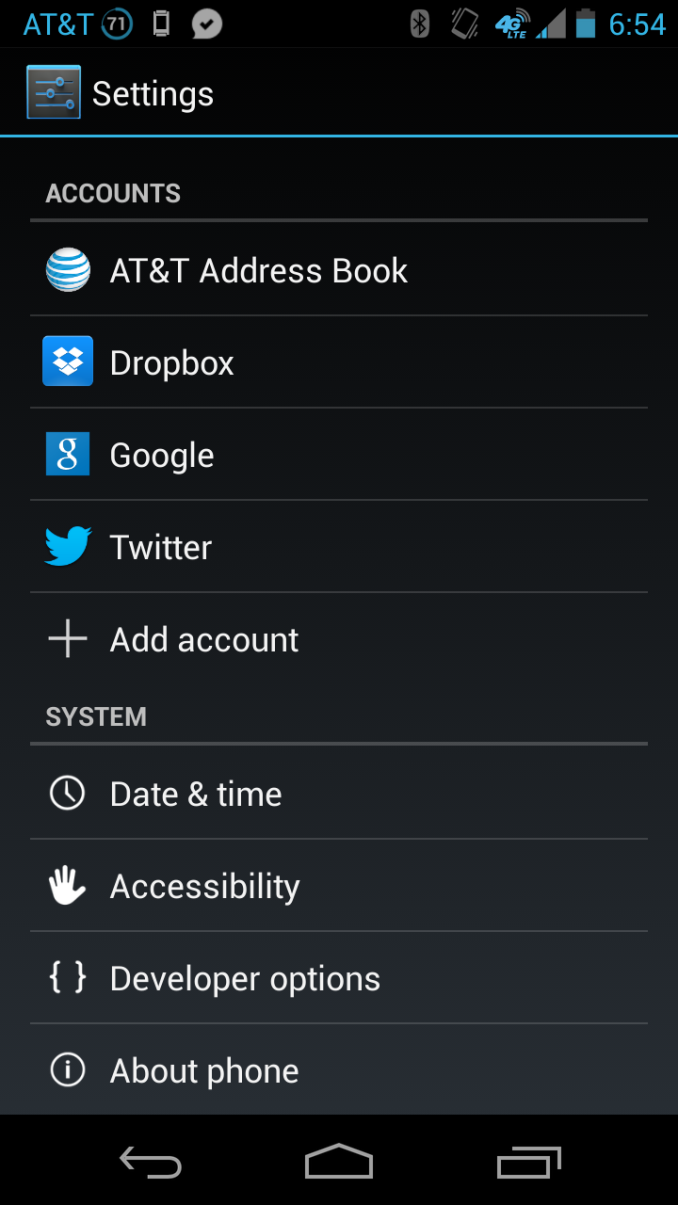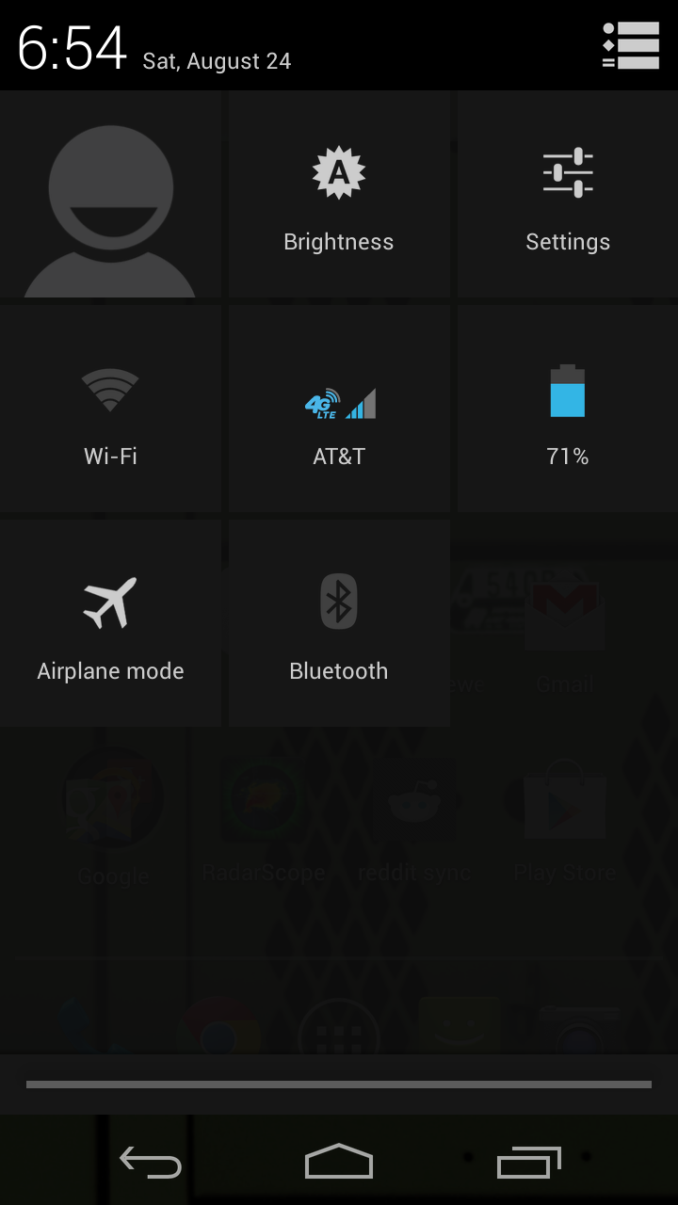Moto X Review
by Brian Klug on August 26, 2013 1:30 PM EST- Posted in
- Smartphones
- Qualcomm
- MSM8960
- Motorola
- Android
- Mobile
- Android 4.2
- Moto X
Somewhat Stock Android
One of the first things that changed for Motorola under its new Google ownership was the final nail through the coffin for Motoblur, with OTA updates for some of its handsets gradually scaling back customized features in favor of stock ones. I joked with Anand that Google paid $12.5 billion for Motorola just to kill the beast that was Motoblur. Truth be told the presence of largely-stock Android 4.x UI is perhaps one of the best qualities of the Moto X.
ro.build.version.full=Blur_Version.139.9.51.ghost_att.ATT.en.US
The Moto X at launch runs Android 4.2.2, which isn’t quite bleeding edge Android, but close. This is essentially an intentional side effect of the Google / Motorola firewalling that we’ve been told is in place. I’m not entirely surprised, but I had hoped the Moto X would differentiate itself by somehow launching with 4.3 considering other handset partners had the Jelly Bean MR2 (4.3) update a while ago, clearly Motorola should’ve as well. I know that Qualcomm had the BSP (Board Support Package) for 4.3 ready for MSM8960Pro at the same time as it did APQ8064, so I can’t think of any technical reason. Again I’d wager Moto X launching with 4.2.2 is entirely political, to say nothing of the usual operator testing nonsense in the USA.
Anyhow the homescreens (widget panels), launcher, settings menu, notification shade, dialer, and default applications are basically unadulterated Android. I say largely unadulterated because to say that the Moto X is entirely stock is still not quite true – there’s the operator name in the top left of the notification bar all the time, and the branded network status indicator (the cartoonish looking AT&T “4G” and “4G LTE” logos) on my AT&T unit. Unnervingly, the network status logo and bars are also a different shade of blue than the battery and time icons adjacent to it.
There’s also AT&T address book preloaded which cannot be removed, which is a huge annoyance. There’s also a provisioning check for bluetooth and WiFi tethering, another indication of an operator-touched device. There’s also AT&T my Wireless and AT&T’s visual voicemail app loaded, but those are pretty understandable.
The Moto X also has a few UI changes that definitely aren't stock. The status bar has different spacing for the cellular and WiFi indicator logos which carries over as a result of Blur (the spacing issue is just the "4G LTE" or similar status logo disappearing when on WiFi). Also the on-screen android buttons sometimes appear transparent, showing what's under, which definitely isn't a stock implementation.
My definition of stock is just that, totally stock – no branded logos, operator names everywhere, or any preloaded apps. Truth be told the Moto X isn’t stock, it just has the stock UI on top of a relatively standard Motorola software build, but it does have a heck of a lot less of the operator preload crapware that normally shows up on Android phones sold with a subsidy these days. Android’s visual style is now mature and appealing enough that it really doesn’t need customization or modification to look good, rather it just needs to be left alone as much as is politically possible. If there’s one thing the Moto X does that every other handset maker should take to heart, it’s exactly that.
If you’re on a wireless operator that can’t work with the newest Nexus phone or Google Play edition devices (like the CDMA ones in the USA – Verizon, Sprint, US Cellular), the Moto X might be the closest you can get to stock, even if it technically isn’t completely so. I suspect this will attract a lot of enthusiasts who are on other operators for their own reasons, even if the longer term solution really should be to vote with your wallet and move to an operator that’s open and compatible with those devices.














105 Comments
View All Comments
Friendly0Fire - Monday, August 26, 2013 - link
I looked for a good replacement for my Nexus S which also had good sound quality and damn that's a hard task especially in NA. I just couldn't find anything short of ordering an international SGS4 and that's just way too expensive.It always makes me sad that we strive for these huge and pretty screens but entirely botch the audio outputs in most smartphones.
kwrzesien - Tuesday, August 27, 2013 - link
Second this. A comparison to tablets would be a great contrast too...we find the iPad 3 headphone out to a Yamaha/Klipsch system superior to any phone (iphones and Androids), would be interested to see the results of the Nexus and Note tablets. Maybe including a comparison of Bluetooth (3/4) and Wi-Fi wireless sound too.tuxRoller - Monday, August 26, 2013 - link
No comment about its superior dynamic range? To my eye, it looked better than even the pureview 1028.Of course, you can't get past the moire artifacts, and lower spatial resolution.
Dan123 - Monday, August 26, 2013 - link
How about the standby efficiency and how it affects battery life. I've seen some reports that it's not so good. You mentioned in the conclusion that you compared battery life without and without the touchless controls, I'd be interested to see how this feature affects standby efficiency.PC Perv - Monday, August 26, 2013 - link
I can't get over the whole irony around the mid-range phone and mid-range screen size. I thought the criteria used to determine "high-end," "mid-range" was the price. The reviewer says this phone is first high-end phone that doesn't sport a large screen, then turn around to say the price is a bit high. Can you get that? It is a high-end phone but the problem is that it's priced as one.Too funny.
Sm0kes - Monday, August 26, 2013 - link
I think your missing the meaning of "high-end". A high-end phone is typically in reference to hardware specifications, design, construction quality, etc.. While this is typically directly related to price (bleeding edge tech and industrial processes cost more), a high price does not automatically mean quality.Also, the facts are pretty clear (for whatever reason) that in the last couple of generations the larger phones tend to have better specs than there smaller counterparts (e.g., HTC One vs. HTC One Mini).
Mondozai - Monday, August 26, 2013 - link
I think you're missing the point.Your sentence:
"While this is typically directly related to price (bleeding edge tech and industrial processes cost more), a high price does not automatically mean quality."
Which is right, but why do you later not connect this statement with the original comment you were replying to? The Moto X is specced like a 2012 phone but is priced like a high-end 2013 phone, especially as the LG G2 is coming out in a matter of weeks and the Note 3 is announced within just 9 days. That doesn't make it a bad phone, but there's a disconnect on the pricing.
kwrzesien - Tuesday, August 27, 2013 - link
The new gold iPhone will be the *only* high-end phone when it comes out.Honest Accounting - Monday, September 16, 2013 - link
What makes the specs 2012? Number of CPU cores? screen resolution? ...mammaldood - Monday, August 26, 2013 - link
Does the Moto X support aptX like other Motorolas?